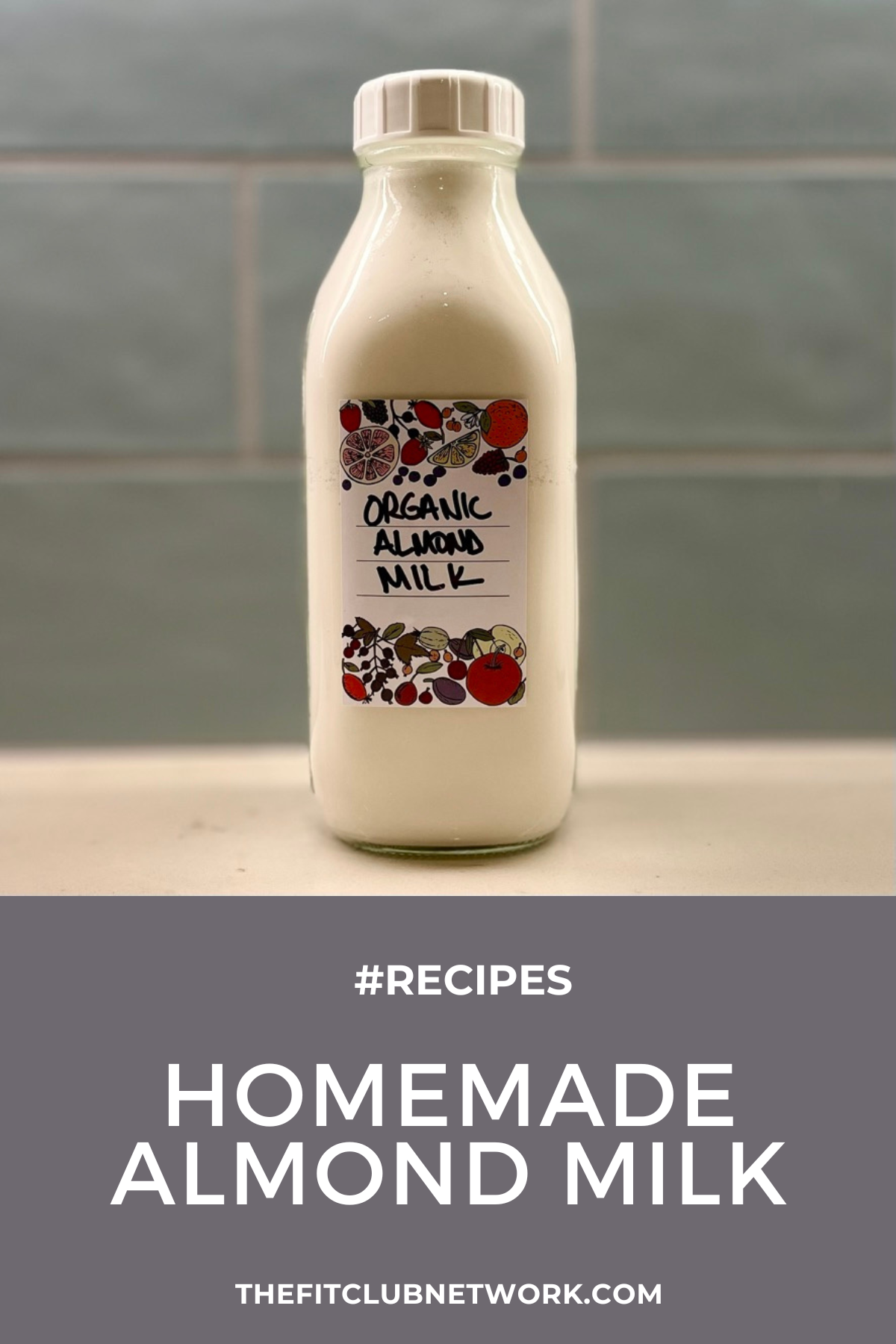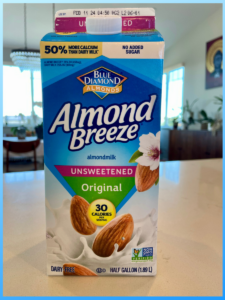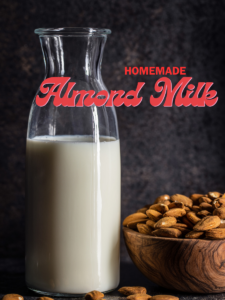
This homemade almond milk recipe could not be easier. All you will need is 1 cup of raw almonds (preferably organic), a high powered blender, some cheese cloth or a nut milk bag, water and some time. But, why? Why bother making homemade almond milk when you can just buy it at the store?
 As a general matter, store bought almond milk isn’t something that is necessarily unhealthy or problematic. We have been using the Almond Breeze brand (Unsweetened Original – 30 Calories) for several years. The Environmental Working Group did an analysis of this very almond milk and found very few issues. While not certified organic, it is certified to be free from genetically engineered ingredients (Non-GMO). There are few concerns. First, it contains “Natural Flavors”. That’s not a major concern, it’s just vague. What flavors? Why add them? Second, it contains Sunflower Lecithin. Lecithin is a natural emulsifier—a substance that helps bond water with fat. There is nothing inherently wrong with emulsifiers, but EWG has noted concerns from impurities in Sunflower Lecithin. In particular, Nitrosamines, which are linked to cancer. Finally, EWG notes the presence of Gellan Gum, a vegetarian ingredient that can even be used as a plant-based substitute for gelatin to keep solids suspended in the liquid. This is a very minor concern. Even with the emulsifiers, we always need to shake the carton before use. The method of processing Almond Breeze is the primary concern EWG has noting, ” Products with moderate and high processing concerns generally have more artificial ingredients, more ingredients that have been significantly modified from whole foods, and more ingredients overall.”
As a general matter, store bought almond milk isn’t something that is necessarily unhealthy or problematic. We have been using the Almond Breeze brand (Unsweetened Original – 30 Calories) for several years. The Environmental Working Group did an analysis of this very almond milk and found very few issues. While not certified organic, it is certified to be free from genetically engineered ingredients (Non-GMO). There are few concerns. First, it contains “Natural Flavors”. That’s not a major concern, it’s just vague. What flavors? Why add them? Second, it contains Sunflower Lecithin. Lecithin is a natural emulsifier—a substance that helps bond water with fat. There is nothing inherently wrong with emulsifiers, but EWG has noted concerns from impurities in Sunflower Lecithin. In particular, Nitrosamines, which are linked to cancer. Finally, EWG notes the presence of Gellan Gum, a vegetarian ingredient that can even be used as a plant-based substitute for gelatin to keep solids suspended in the liquid. This is a very minor concern. Even with the emulsifiers, we always need to shake the carton before use. The method of processing Almond Breeze is the primary concern EWG has noting, ” Products with moderate and high processing concerns generally have more artificial ingredients, more ingredients that have been significantly modified from whole foods, and more ingredients overall.”
Which brings me to the point: You simply do not need all these ingredients in your almond milk. Yes, the homemade almond milk will settle and you’ll need to shake the container before use, but that is a small price to pay to consume almond milk that has all of three ingredients in it: Almonds, Water and a pinch of salt (optional). Again, there is nothing inherently wrong with using this Almond Breeze brand and it is something that has been a part of our diet for years, but if you can make it yourself you can limit the ingredients in your food and even add flavoring to your personal preference!
Quick note on cost. The price of organic raw almonds varies from store to store. At one store, they were $14.99 per pound. We found them at Sprouts for $9.99 per pound. One cup of almonds weighs approximately 1/2 a pound, so the cost to produce 4 cups using this homemade almond milk recipe is about $4.95. In fairness, 4 cups is only 1/4 of a gallon. Compare that to the 1/2 gallon container of Almond Breeze we purchased for $6.99. You’d need a full pound of almonds to make 1/2 a gallon of homemade almond milk, so it is slightly more expensive than store bought almond milk, based on the pricing in this example. It may vary where you live, so shop around, but that’s how the math breaks down. Just compare the price for 1 pound of organic almonds to the price of Almond Breeze. I suspect this is because we are using organic almonds and, as noted above, Almond Breeze is not certified organic, only Non-GMO. We are willing to pay a little more and put in some effort to eat organic, but that’s a personal choice. Read more on why organic and Non-GMO ingredients are important HERE. We will be searching for more cost effective options, including buying direct from farmers and I’ll keep you updated on that.

Homemade Almond Milk Ingredients:
- 1 cup raw almonds, soaked in water for 4 to 6 hours. The longer you soak them, the easier it will be to blend them.
- 4-5 cups filtered water (less for thicker, more for thinner milk). We prefer the consistency of the 4 cup recipe.
- Pinch of sea salt (optional)
- Some people add 1/2 teaspoon vanilla extract, but this is optional and we personally prefer it without the flavoring.
Homemade Almond Milk Recipe:
- Drain the soaked almonds and rinse them well.
- Add the almonds and water to a high-powered blender.
- Blend for 1-2 minutes, until very smooth and creamy.
- Strain the almond milk through a cheesecloth or nut milk bag into a large bowl or pitcher.
- Gently press the pulp to extract as much milk as possible. Discard the pulp or compost it.
- Add the salt and vanilla extract (if using) and stir well.
- Taste and adjust the sweetness or thickness to your liking. You can add more water for a thinner consistency.
- Store the almond milk in an airtight container in the refrigerator for up to 3-5 days.
Tips:
- Soak the almonds for longer for a smoother and creamier milk.
- Use filtered water for the best taste.
- Experiment with different sweeteners like honey, dates, or even banana for a natural sweetness.
- Add other flavors like cinnamon, nutmeg, or cocoa powder for a variety of options.
- You can use the leftover almond pulp in baking, smoothies, or granola bars.
That’s it. We keep it pretty simple and use only almonds and water with a pinch of salt. The only time consuming part of the process is the 4 to 6 hours you have to wait while soaking the almonds, but the actual process of producing the homemade almond milk takes just a few minutes. We love doing stuff like this and staying involved in the processing of the foods we consume and this one is just too easy.




